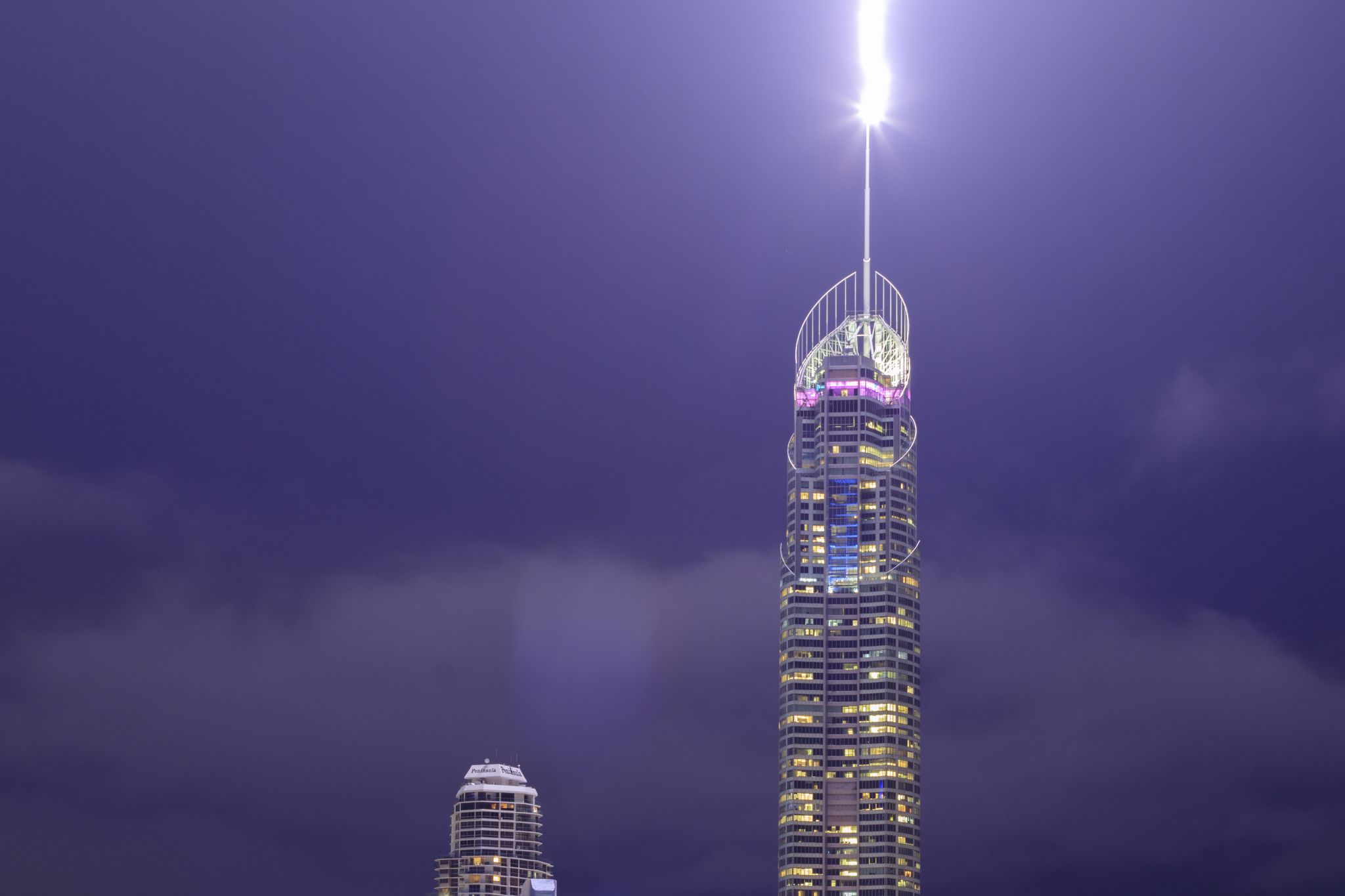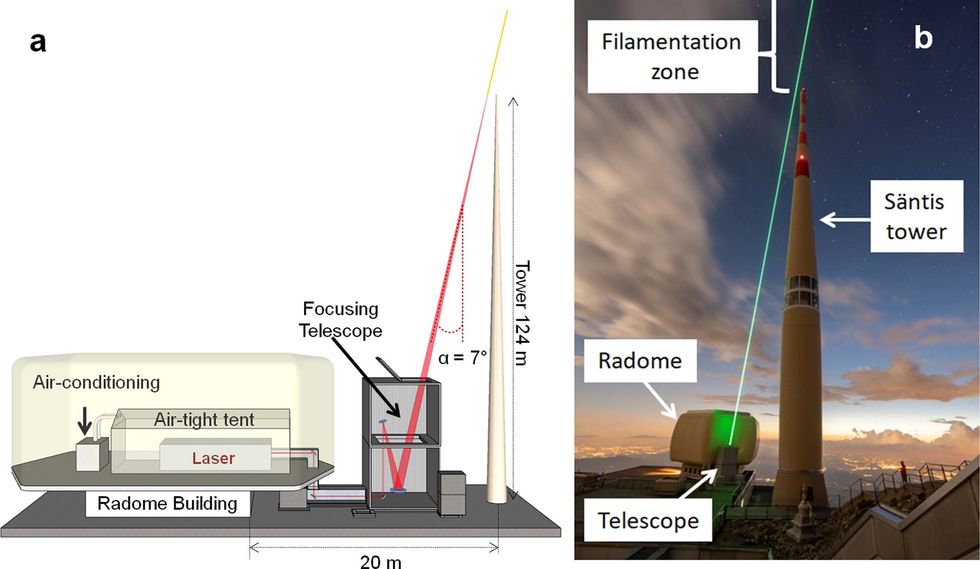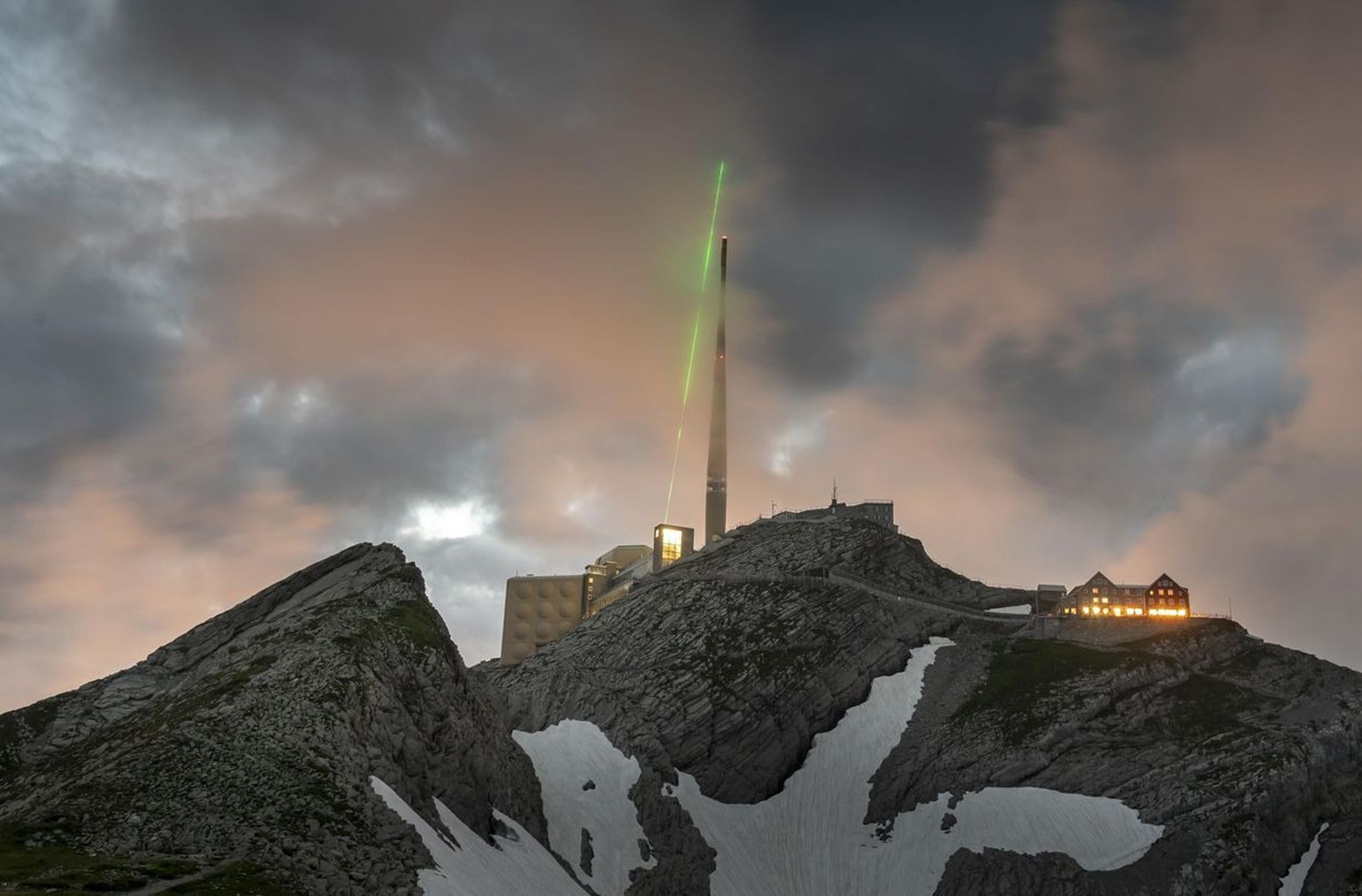The arrival of a lightning bolt is an unmistakable phenomenon: a flash of light illuminates the sky as a buildup of electric charge connects with an object to release 300 million volts of electric potential—that’s enough to power 25 million 12-volt car batteries.
This kind of energy is not only a fatal risk to humans (on average, 28 people in the US die each year from a lightning strike), but can pose a risk to infrastructure as well, including rocket launch pads and airports. As a rule of thumb, these bolts of energy will seek out the tallest objects in an environment—like trees, skyscrapers, and mountains—however, depending on where the charge accumulates, lightning can strike open fields as well.
But strikes may become a little bit safer, thanks to breakthrough research published earlier this year in the journal Nature Photonics. The new work demonstrated the use of a laser lightning rod to redirect dangerous bolts.
This rod can protect a much larger area than the traditional lightning rod, and can be used dynamically as well, the paper’s first author, Aurélien Houard, Ph.D., tells Popular Mechanics. “In theory, there is no limitation in the length of this [‘rod’] if you have sufficient energy in the laser,” says Houard, a physics research scientist at The Polytechnic Institute of Paris. “And you can also easily direct this rod by steering the laser beam.”
Lightning Rods Have Remained Fundamentally the Same
While Houard and his team’s laser lightning rod represents a new era of lightning protection, it’s not the first lightning rod to do so. For the last 300 years or so, scientists have relied on Benjamin Franklin’s original design to safely redirect lightning strikes.
These pointed rods are typically installed at the tallest points of buildings and connect to a buried conductive wire. As they stick out above other targets, these higher points serve as the first line of defense to absorb strikes and send them safely underground. However, while the rods work well in smaller cases—such as directing lightning away from a house—they fail in larger applications like protecting airports.
“The Franklin rod is very efficient to attract lightning and protects over a surface proportional to its height, and limited to a 30-meter radius,” Houard explains. “For larger distances and taller structures, there is no available protection.”
Pierre Walch, Ph.D., is coauthor on the new paper and a research engineer at The Polytechnic Institute of Paris. He tells Popular Mechanics that researchers had been working toward a laser-based alternative to the Franklin lightning rod for decades, but previous attempts had fallen flat.
“The idea of guiding electrical discharges using a laser and the concept of a laser lightning rod are not new and were documented as early as the 1970s,” Walch says. However, the lasers were not powerful or fast enough, and they weren’t positioned in lightning-prone locations.
To help bring this technology into the 21st century, the researchers stacked the deck. The team not only increased the laser’s power to 500 millijoules, with bursts of energy every 1 thousandths of a second, but also took it to the top of one of Europe’s most lightning strike-prone mountains: Säntis mountain in the Swiss Alps.
Laser Lightning Rods Carve an Easier Path For Electricity
But how does a powerful laser beam help divert bolts of lightning? Walch explains that it all depends on the path that the laser leaves behind. When laser pulses are shot into the sky, their intense heat ionizes the air, leaving behind a channel of plasma. Similarly to how rivers cut through rock over millennia, these ionized laser beams carve out channels in the surrounding air. And when this plasma dissipates, says Walch, the channels leave behind a direct path for lightning to follow.
Here’s what actually happens behind the scenes:
“While it might seem intuitive at first to think that this plasma is responsible for conducting the lightning, its short-lived nature causes it to dissipate by recombining with the surrounding air,” Walch says. “However, this recombination of the plasma induces a heating of the air, resulting in a long-lived, under-dense air channel. Due to its lower density, this under-dense channel defines a preferential path for the lightning propagation, effectively guiding its course.”
Like a Franklin rod, a lightning bolt would then follow the air channel down the laser path to dissipate safely into the ground.
In 2021, Houard, Walch, and colleagues tested their laser lightning rod at the summit of Säntis mountain over a period of six hours, and successfully diverted lightning strikes four times. Their data showed that the strikes traveled 50 meters along the rod’s path, making its total protection area larger than a shorter Franklin rod.
But You Won’t See These Lasers During Storms Anytime Soon
Despite this successful proof-of-concept demonstration, laser lightning rods still face obstacles along their path to adoption.
For example, while Franklin rods are “on duty” 24/7, should a lightning bolt strike, laser lightning rods would need to be fired up in anticipation of a bolt; the laser rods could easily miss the bolt if it ends up striking too far afield.
“After the laser shuts off, the conductivity of the air rapidly vanishes, not allowing enough charge to flow, to launch and maintain [an electric spark],” Joseph Dwyer, Ph.D., a physics and astronomy professor at the University of New Hampshire, who was not involved in the new research, tells Popular Mechanics.
Intelligent monitoring of the surrounding electric fields that impending lightning strikes cause could partially address this concern, Houard says. But even so, laser lightning rod projects will still need additional testing to further quantify their effect and safety, as well as the funding to make that possible.
Should these pieces come together in the coming years, Houard and Walch are excited about the possibilities of laser lightning rods—such as using them to trigger lightning strikes before they reach sensitive areas. The technology may even have applications for scientific research, Victor Moreno, a co-author on the new paper and Ph.D. candidate at the University of Geneva in Switzerland, tells Popular Mechanics. These could include atmospheric science and remote sensing.
As for what innovation might be around the corner to one day surpass the laser lightning rod, Walch isn’t sure any such thing exists.
“Even while reading science fiction, I do not find a lot of things that scream ‘future’ as [much as] a laser,” he says. “So, it is difficult for me to imagine something more advanced than a laser-based lightning rod.”
Editor’s Correction: A previous version of this story incorrectly stated the laser’s power as ‘500 megajoules, with bursts of energy every 1 trillionth of a second.’ This has been corrected to ‘500 millijoules, with bursts of energy every 1 thousandths of a second.’

Sarah is a science and technology journalist based in Boston interested in how innovation and research intersect with our daily lives. She has written for a number of national publications and covers innovation news at Inverse.
















